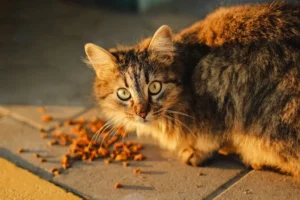Cats may be cherished for their companionship and antics, but they have one major limitation – they cannot speak to us in words. Have you ever wondered why that is the case?
Cats have physical limitations that prevent them from speaking like humans. Let’s explore the reasons behind why cats are unable to communicate through speech.
The Anatomy of a Cat’s Voice Box
Cats have a unique anatomy that differs from humans when it comes to their voice box. Unlike humans who have vocal cords that can move and produce a wide range of sounds, cats have a larynx that is not as versatile. The larynx of a cat is positioned higher in the throat, making it more challenging for them to produce the complex sounds that humans can.
Additionally, cats have a smaller mouth and a different vocal fold structure, limiting their ability to form words like humans do. This anatomical difference plays a crucial role in why cats cannot speak like humans. While cats may not be able to vocalize words, they make up for it with a wide range of vocalizations, including meows, purrs, hisses, and growls, each serving a different communication purpose.
Communication Through Body Language
Cats are masters of communication, relying not only on vocalizations but also heavily on body language to express their needs and emotions. By paying attention to a cat’s body posture, ears, tail movements, and facial expressions, you can decipher what they are trying to communicate.
For example, a cat with flattened ears and a twitching tail may be showing signs of aggression or fear, while a cat gently purring and kneading you with its paws is expressing affection and comfort. Understanding these subtle cues in a cat’s body language is key to building a strong bond with your feline friend.
In addition to body language, cats may also use vocalizations to convey their feelings. Each meow or purr has a specific meaning, and by observing your cat’s vocal cues alongside their body language, you can better understand what they are trying to tell you. Remember, while cats may not be able to speak like humans, they have their own sophisticated language that is worth learning to enhance your relationship with them.
Evolutionary Factors
Cats’ inability to speak can be attributed to evolutionary factors. Throughout their evolution, cats have developed alternative means of communication that better suit their solitary and hunting nature. Silent hunting has been crucial to cats’ survival, which means vocal communication was not as necessary for their hunting success. Unlike social species that heavily rely on vocalizations to coordinate group activities, cats primarily hunt alone and have limited social structures, leading to less need for complex vocal communication. Thus, over time, cats have evolved to communicate through body language, scent marking, and visual signals rather than through speech.
Social Hierarchy and Communication
Within their social structures, cats use various forms of communication to establish territorial boundaries and social hierarchy. While vocalizations do occur, they are not as widespread or essential as in other species. Cats are known for their independent nature and self-reliance, leading to limited reliance on speech for social interactions. Instead, they use postures, tail movements, and facial expressions to convey messages to other cats. Cats prioritize subtle cues and non-verbal communication to navigate their social dynamics, relying less on vocalizations for day-to-day interactions.
Unique Insight : Cats’ purring is a notable form of vocal communication that serves various purposes. While not a form of speech, purring can indicate contentment, relaxation, or even serve as a self-soothing mechanism. This gentle sound is one of the few vocalizations cats use regularly, showcasing how they prioritize subtle forms of communication over speech.
Social Structures : Cats have developed complex hierarchies within their social groups, often building upon a dominant-subordinate dynamic. Meows and other vocalizations are usually reserved for interactions with humans, as cats adapt their communication styles based on the species they’re interacting with.
Training and Mimicry
Cats have a unique vocal structure that limits their ability to speak like humans. While they can be trained to mimic certain sounds, such as meowing in response to specific cues, their vocal cords and anatomy simply don’t allow for the complex sounds necessary for human speech. So, even though Fluffy may try to imitate your words, it won’t be as articulate as a conversation with a human.
The Myth of the Silent Cat
Contrary to popular belief, cats are not completely silent creatures. They communicate through a variety of vocalizations, including meows, purrs, hisses, and even chirps. Each sound serves a different purpose, from indicating hunger or affection to expressing displeasure. So, the next time Mittens meows at you, remember that it’s their way of speaking to you in their own feline language.
Unique Insight: Common Cat Sounds
- Meow: Used to communicate with humans, especially for attention or food.
- Purr: Sign of contentment or relaxation, often heard when being petted.
- Hiss: Indicates fear, aggression, or discomfort.
- Chirp: A friendly greeting or expression of excitement.
- Yowl: Typically signifies distress or mating behavior.
Remember, while cats may not speak like humans, they have a rich repertoire of sounds to convey their feelings and needs. So, pay attention to your feline friend’s vocal cues to better understand what they’re trying to communicate.
Cats in Literature and Popular Culture
Cats have long captured the imagination of writers, filmmakers, and artists, but have you ever wondered why they are often portrayed as silent companions in literature and popular culture? The inability of cats to speak has been a common theme in stories and movies, adding to their mysterious and enigmatic allure. From the Cheshire Cat in “Alice in Wonderland” to Salem in “Sabrina the Teenage Witch,” cats are often depicted as wise and observant creatures who communicate through their actions rather than words. This portrayal highlights the significance of non-verbal communication in understanding our feline friends.
Significance of Non-Verbal Communication
As much as we wish our cats could talk to us, understanding their non-verbal cues is crucial for effective communication and bonding. From purring to tail flicks, cats use a variety of gestures and vocalizations to express their needs and emotions. By paying attention to these signals, you can better respond to your cat’s desires and build a strong and trusting relationship. Remember, a well-timed chin rub or a slow blink can speak volumes in the language of cats.
Key Tips for Understanding Your Cat’s Non-Verbal Communication: 1. Tail Position: A high tail signifies confidence, while a low tail may indicate fear or submission. 2. Ears: Forward-facing ears show interest, while flattened ears suggest aggression or fear. 3. Purring: While often associated with contentment, cats may also purr when they are stressed or unwell. 4. Eye Contact: Slow blinks are a sign of trust, while prolonged stares can be perceived as a challenge. 5. Body Posture: Arched back and raised fur signal aggression, while a relaxed, elongated body indicates comfort.
By embracing the nuances of a cat’s non-verbal language, you can deepen your bond with your feline companion and navigate the mysteries of their silent world with confidence and understanding.
Alex, a passionate animal lover, has experience in training and understanding animal behavior. As a proud pet parent to two dogs and three cats, he founded AnimalReport.net to share insights from animal experts and expand his knowledge of the animal kingdom.









